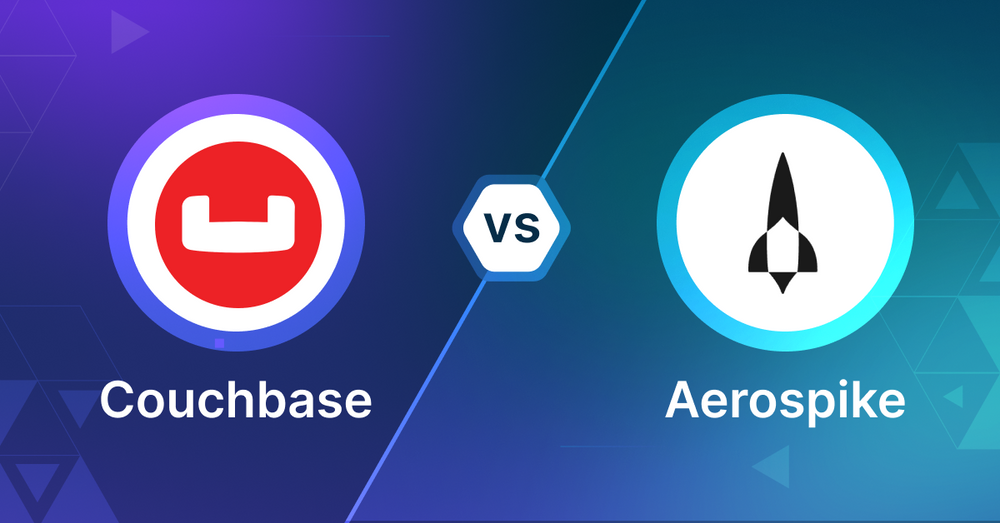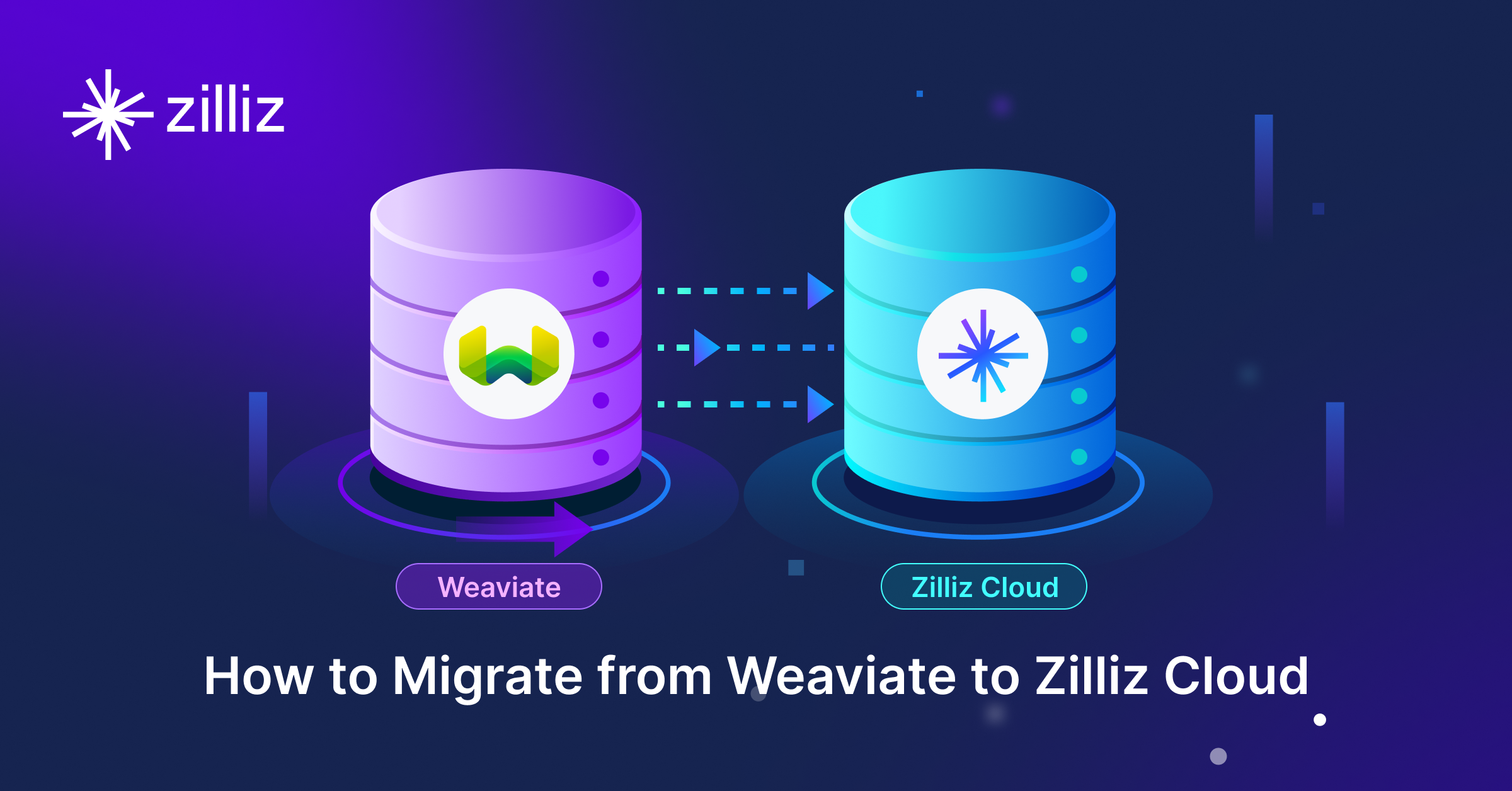Couchbase vs Aerospike: Choosing the Right Vector Database for Your AI Apps

What is a Vector Database?
Before we compare Couchbase and Aerospike, let's first explore the concept of vector databases.
A vector database is specifically designed to store and query high-dimensional vectors, which are numerical representations of unstructured data. These vectors encode complex information, such as the semantic meaning of text, the visual features of images, or product attributes. By enabling efficient similarity searches, vector databases play a pivotal role in AI applications, allowing for more advanced data analysis and retrieval.
Common use cases for vector databases include e-commerce product recommendations, content discovery platforms, anomaly detection in cybersecurity, medical image analysis, and natural language processing (NLP) tasks. They also play a crucial role in Retrieval Augmented Generation (RAG), a technique that enhances the performance of large language models (LLMs) by providing external knowledge to reduce issues like AI hallucinations.
There are many types of vector databases available in the market, including:
- Purpose-built vector databases such as Milvus, Zilliz Cloud (fully managed Milvus)
- Vector search libraries such as Faiss and Annoy.
- Lightweight vector databases such as Chroma and Milvus Lite.
- Traditional databases with vector search add-ons capable of performing small-scale vector searches.
Couchbase is distributed multi-model NoSQL document-oriented database with vector search capabilities as an add-on. Aerospike is also a distributed, scalable NoSQL database with vector search added on. This post compares their vector search capabilities.
What is Couchbase? An Overview
Couchbase is a distributed, open source NoSQL database for cloud, mobile, AI and edge computing. It combines the best of relational databases with the flexibility of JSON. Couchbase also allows you to do vector search even though it doesn’t have native vector indexes. Developers can store vector embeddings—numerical representations generated by machine learning models—within Couchbase documents as part of their JSON structure. These vectors can be used in similarity search use cases such as recommendation systems or retrieval-augmented generation both based on semantic search where finding data points close to each other in a high dimensional space is important.
One way to do vector search in Couchbase is by using Full Text Search (FTS). FTS is designed for text search but can be used for vector search by converting vector data into searchable fields. For example, vectors can be tokenized into text-like data and FTS can index and search based on those tokens. This will give you approximate vector search and a way to query documents with vectors that are close in similarity.
Alternatively developers can store the raw vector embeddings in Couchbase and do the vector similarity calculations at the application level. This means retrieving documents and computing metrics such as cosine similarity or Euclidean distance between vectors to find the closest matches. This way Couchbase will be used as storage for vectors and the application will handle the math.
For more advanced use cases some developers integrate Couchbase with specialized libraries or algorithms that enable vector search. These integrations allow Couchbase to manage the document store and the external libraries will do the actual vector comparisons. This way Couchbase can still be part of a solution that does vector search.
By using these approaches Couchbase can be used for vector search functionality and be a flexible option for various AI and machine learning use cases that require similarity search.
What is Aerospike? An Overview
Aerospike is a NoSQL database for high-performance real-time applications. It has added support for vector indexing and searching so it’s suitable for vector database use cases. The vector capability is called Aerospike Vector Search (AVS) and is in Preview. You can request early access from Aerospike.
AVS only supports Hierarchical Navigable Small World (HNSW) indexes for vector search. When updates or inserts are made in AVS, record data including the vector is written to the Aerospike Database (ASDB) and is immediately visible. For indexing, each record must have at least one vector in the specified vector field of an index. You can have multiple vectors and indexes for a single record so you can search on the same data in different ways. Aerospike recommends assigning upserted records to a specific set so you can monitor and operate on them.
AVS has a unique way of building the index, it’s concurrent across all AVS nodes. While vector record updates are written directly to ASDB, index records are processed asynchronously from an indexing queue. This is done in batches and distributed across all AVS nodes, so it uses all the CPU cores in the AVS cluster and is scalable. Ingestion performance is highly dependent on host memory and storage layer configuration.
For each item in the indexing queue, AVS processes the vector for indexing, builds the clusters for each vector and commits those to ASDB. An index record contains a copy of the vector itself and the clusters for that vector at a given layer of the HNSW graph. Indexing uses vector extensions (AVX) for single instruction, multiple data parallel processing.
AVS queries during ingestion to “pre-hydrate” the index cache because records in the clusters are interconnected. These queries are not counted as query requests but show up as reads against the storage layer. This way the cache is populated with relevant data and can improve query performance. This shows how AVS handles vector data and builds indexes for similarity search so it can scale for high-dimensional vector searches.
Key Differences
When choosing between Couchbase and Aerospike for vector search, there are several factors to consider. Let’s break it down to help you decide.
In terms of search methodology, Couchbase doesn’t have native vector indexes but has workarounds for vector search. It uses Full Text Search (FTS) by converting vector data into searchable fields. Developers can also store raw vector embeddings and do similarity calculations at the application level. Aerospike has dedicated vector search capabilities. It has Hierarchical Navigable Small World (HNSW) indexes for vector search. The Aerospike Vector Search (AVS) feature is for high-dimensional vector searches.
For data handling, Couchbase combines features of relational databases with the flexibility of JSON. It allows storing vector embeddings in JSON documents. Aerospike is for high-performance, real-time applications. It supports multiple vectors and indexes per record so you can have multiple search approaches.
Scalability and performance are key. As a distributed NoSQL database, Couchbase is designed for scalability. But performance for vector search depends on the implementation. Aerospike does concurrent indexing across all AVS nodes so it uses all the CPU cores in the cluster. Ingestion performance is dependent on host memory and storage layer configuration.
Flexibility and customization options are different. Couchbase gives you flexibility in vector search implementation so you can choose between built-in features and custom solutions. It supports integration with specialized libraries for more advanced vector search capabilities. Aerospike has a dedicated vector search solution with AVS and allows multiple vectors and indexes per record for flexible search configurations.
Integration and ecosystem support are also important. Couchbase supports cloud, mobile, AI and edge computing scenarios. It can be integrated with external libraries for more vector search functionality. Aerospike is for high-performance, real-time applications and AVS integrates directly with the main Aerospike database.
Ease of use is different. Couchbase requires custom implementation for vector search which adds complexity. Developers need to do vector similarity calculations if using the raw storage approach. Aerospike has a dedicated vector search solution which simplifies implementation. But AVS is currently in Preview and requires early access request.
Additional considerations: Couchbase is good for recommendation systems and retrieval-augmented generation. It allows developers to implement vector search using database concepts they are familiar with. Aerospike gives immediate visibility of vector data after writes or updates. It uses vector extensions (AVX) for parallel processing during indexing and pre-hydration strategy to populate the index cache which can improve query performance.
When to Use Each
Couchbase is for situations where data flexibility and versatility is key. It’s good for projects that need a combination of traditional database features and vector search, especially when working with JSON documents. Couchbase is great for situations where you need to add vector search to existing applications that already use JSON based data structures. It’s perfect for recommendation systems, content retrieval and applications that can store and query both structured and unstructured data alongside vector embeddings. Choose Couchbase when you need a database that can handle many data types and querying methods and you’re willing to implement custom vector search or integrate with external libraries for more advanced vector operations.
Aerospike is for when you need a dedicated high performance vector search solution for real-time applications. It’s good for use cases that require fast and efficient processing of high dimensional vector data at scale. Aerospike’s Vector Search (AVS) feature is great for machine learning, artificial intelligence and advanced analytics where similarity searches are critical. Choose Aerospike when vector search is your primary focus and you need to handle large volumes of vector data with low latency. It’s perfect for projects that need concurrent indexing across multiple nodes and can benefit from hardware acceleration for vector processing.
Summary
Couchbase’s strengths are in its flexibility, JSON support and ability to add vector search to a NoSQL database. It gives developers the freedom to implement custom vector search within a familiar database environment. Aerospike excels with its dedicated vector search feature, optimized for high performance real-time applications. It has built-in vector indexing and searching, making it a great choice for specialized vector search.
Choose between Couchbase and Aerospike based on your use cases, data types and performance requirements. If you need a flexible database that can handle many data types and vector search alongside other database operations, Couchbase might be the way to go. If high performance vector search in real-time applications is your primary focus, Aerospike might be more suitable. Consider your existing infrastructure, your development team’s expertise and your application’s requirements when making your decision. Remember the best choice will be the one that fits your project’s needs and long term goals.
While this article provides an overview of Couchbase and Aerospike, it's key to evaluate these databases based on your specific use case. One tool that can assist in this process is VectorDBBench, an open-source benchmarking tool designed for comparing vector database performance. Ultimately, thorough benchmarking with specific datasets and query patterns will be essential in making an informed decision between these two powerful, yet distinct, approaches to vector search in distributed database systems.
Using Open-source VectorDBBench to Evaluate and Compare Vector Databases on Your Own
VectorDBBench is an open-source benchmarking tool designed for users who require high-performance data storage and retrieval systems, particularly vector databases. This tool allows users to test and compare the performance of different vector database systems such as Milvus and Zilliz Cloud (the managed Milvus) using their own datasets and determine the most suitable one for their use cases. Using VectorDBBench, users can make informed decisions based on the actual vector database performance rather than relying on marketing claims or anecdotal evidence.
VectorDBBench is written in Python and licensed under the MIT open-source license, meaning anyone can freely use, modify, and distribute it. The tool is actively maintained by a community of developers committed to improving its features and performance.
Download VectorDBBench from its GitHub repository to reproduce our benchmark results or obtain performance results on your own datasets.
Take a quick look at the performance of mainstream vector databases on the VectorDBBench Leaderboard.
Read the following blogs to learn more about vector database evaluation.
Further Resources about VectorDB, GenAI, and ML
- What is a Vector Database?
- What is Couchbase**? An Overview**
- What is Aerospike**? An Overview**
- Key Differences
- When to Use Each
- Summary
- Using Open-source VectorDBBench to Evaluate and Compare Vector Databases on Your Own
- Further Resources about VectorDB, GenAI, and ML
Content
Start Free, Scale Easily
Try the fully-managed vector database built for your GenAI applications.
Try Zilliz Cloud for FreeKeep Reading

Introducing Zilliz Cloud Global Cluster: Region-Level Resilience for Mission-Critical AI
Zilliz Cloud Global Cluster delivers multi-region resilience, automatic failover, and fast global AI search with built-in security and compliance.

Why Teams Are Migrating from Weaviate to Zilliz Cloud — and How to Do It Seamlessly
Explore how Milvus scales for large datasets and complex queries with advanced features, and discover how to migrate from Weaviate to Zilliz Cloud.

Beyond PGVector: When Your Vector Database Needs a Formula 1 Upgrade
This blog explores why Postgres, with its vector search add-on, pgvector, works well for smaller projects and simpler use cases but reaches its limits for large-scale vector search.
The Definitive Guide to Choosing a Vector Database
Overwhelmed by all the options? Learn key features to look for & how to evaluate with your own data. Choose with confidence.